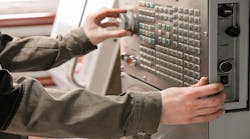Manufacturers talk a lot about preventative and predictive maintenance strategies for efficient asset utilization and for preventing equipment failure. Yet, there are cases in which a run-to-failure (RTF) strategy provides operators with greater equipment uptime and reduced operating expenditure. We should review two maintenance strategy definitions before exploring the five cases in which an RTF strategy may apply.
Reactive and corrective maintenance defined – The terms “reactive maintenance” and “corrective maintenance” often are confused. Reactive maintenance requires no thought or planning, running equipment until it breaks, and carrying out emergency repairs to restore the equipment to operation. Whether this is done inadvertently or intentionally, expect shorter equipment life, expensive maintenance costs, inefficient use of time, and late order delivery, with statistics showing that equipment failure is the cause of 42 percent of unplanned downtime.
Corrective maintenance forms part of a preventative maintenance program, consisting of planned and unplanned interventions. The planned interventions are condition-based, arising from scheduled maintenance observations, while unplanned interventions occur when unexpected failure occurs between scheduled maintenance tasks.
Reactive maintenance is the absence of a maintenance plan. Corrective maintenance uses intelligent analysis and strategy selection to optimize equipment availability, total cost-of-ownership, and efficient use of resources.
A targeted, run-to-failure strategy sits within the corrective maintenance component of a comprehensive preventative maintenance program, supported by data.
Advantages of RTF maintenance:
● Once the decision is taken to implement RTF on an asset, no planning is required other than for adequate spares.
● Decision-making becomes binary and easy to comprehend. Either the asset is working and left alone, or it has failed and been replaced/repaired.
● Maintenance overheads are reduced.
Disadvantages of RTF maintenance:
● Increased inventory costs to ensure spares are on-hand to minimize production stoppages.
● The unpredictability of failure makes scheduling technicians difficult.
● The inconsistency of failures means spares holdings and technical resource levels are hard to forecast.
With this background, let’s consider five scenarios supporting a run-to-failure strategy for manufacturing assets.
1) Assets with a high mean time between failure. Assets with a high mean-time-between-failure (MTBF) or an unpredictable component failure rate may suit an RTF strategy. Maintenance interventions have a cost, with production stopped and technicians and spares deployed.
If an asset has an MTBF equating to years of operation, the costs of regularly scheduled maintenance can outweigh the cost of rectification upon detecting failure. Similarly, an unpredictable component failure rate obviates regular preventative maintenance success in preventing failure.
Examples of assets with high MTBF include electronic components or specific building structures, where regular tests and observation will incur a cost but yield no advantage in discerning imminent failure.
2) Non-critical assets. Maintenance expenditure follows equipment criticality. While it would be hard to envisage a business operating unnecessary assets, there are cases wherein sufficient equipment redundancy exists to mitigate the impact of one asset failing. This mitigation may consist of returning to operation an asset under maintenance, a minor reduction in productive capacity until the asset is rectified, or no impact whatsoever in the short term.
With such assets, regularly scheduled maintenance interventions can impose costs that decrease monthly operating margins. An RTF strategy will ensure that spares holdings and capability exist for timely rectification upon failure. The cost of a short-term loss in productive capacity is more than offset by reducing maintenance overhead and regularly scheduled downtime.
An example of a non-critical asset would be a single fan in a bank of cooling fans, or one conveyor where two others are available to take up extra capacity.
3) Low capitalization assets. The cost of a maintenance technician's time can be steep, and an hour of maintenance cost may equate to a high percentage of the value of some assets. In those cases, regular maintenance, other than the occasional cleaning or test-and-tag, is a wasted resource. Having identified such assets within a preventative maintenance program, the implementation of an RTF strategy is supported by ensuring adequate replacements are held in stock or readily available.
Examples of low-capitalization assets include electric hand drills, computer monitors, or barcode scanners.
4) Short-life assets. When an asset has a limited lifespan, maintenance time and money invested in that asset could be better spent. Examples of short-life assets include recirculation pumps, sump pumps, lights, light ballasts, frequent-use keypads, or pneumatic actuators on assembly lines.
5) Disposable assets. Assets that are designed to be disposable are frequently categorized as RTF, while ensuring sufficient spares inventory. Examples of disposable assets include valves, batteries, some variable frequency drives, and CCTV equipment.
Considerations when implementing an RTF strategy. Personnel safety, production downtime, equipment reliability, and asset redundancy are four factors to review when analyzing the applicability of an RTF maintenance strategy.
When equipment failure compromises personnel safety, an RTF strategy is inappropriate unless mitigating actions encompass the first three levels from the hierarchy of controls: elimination, substitution, or engineering. RTF makes no economic sense when the cost of unplanned production downtime outweighs the cost of more interventionist maintenance strategies, while using RTF on assets with poor reliability or no redundant capacity will increase maintenance costs and reduce equipment life, contributing to increased total ownership costs.
In summary, a Run-to-Failure maintenance strategy is not an abdication of responsibility when it’s part of a considered maintenance program, backed by defensible economic and safety analyses, and supported by a modern computerized maintenance management program (CMMS). When manufacturers seek to maximize or maintain margins in an ever-competitive environment, Run-to-Failure forms a critical weapon in the corrective maintenance arsenal of an optimized and cost-focused preventative maintenance program.
Bryan Christiansen is the founder and CEO of Limble CMMS. Limble is a modern, easy-to-use mobile CMMS software that takes the stress and chaos out of maintenance by helping managers organize, automate, and streamline their maintenance operations.






